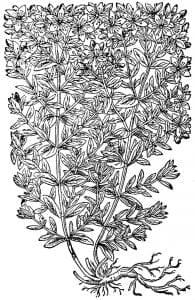Modern herbalists turn to Elder during flu and cold season as a powerful preventative and cure. Elderberries are added to teas for daily consumption to build the body’s strength, citing scientific studies that show Elderberries help strengthen cell walls by mitigating the damage done by free radicals through the antioxidant constituents anthocyanins (Cejpek). They’re added to formulas designed to ease fever and other flu and cold symptoms due to their antiviral and antibacterial action (Zakay-Rones) and are often taken straight up as a syrup for those same actions when illness strikes. Elder flowers are used primarily for fevers by modern herbalists for many of the same reasons.
A quick internet search is guaranteed to turn up a plethora of recipes, articles, and references to using Elderberry as a flu and cold remedy…alongside a host of other brilliant herbs who could potentially help out with symptoms like sore throat, coughing and congestion, fever, nausea, and diarrhea that go hand-in-hand with the flu and cold season. The question is, when does Elder really shine as a flu and cold medicine…or, better yet, is it the right herb for what ails you today?
Energetics of Elderberry and Elder Flower
Elder has been used by traditional herbalists and healers for centuries for far more than just colds and flus. Elder’s primary action, energetically speaking, is to dry and cool. From an Ayurvedic perspective, the berries and flowers are both used to decrease Pitta and clear excess Kapha, thus clearing inflammation and stagnation of phlegm. Although Elderberries and flowers are not part of the Traditional Chinese Medicine’s materia medica, they are described as cooling and are used to release the exterior with an affinity for the liver and lung meridians (Tierra). TCM practitioners have used Japanese or Chinese Elder bark, roots, and stems as a purgative, a use Traditional Western Herbalists through out Europe once drew upon although it is rarely incorporated into modern herbal formulas.
Traditional Western Herbalism is where Elder medicine has been best documented and most used. According to Mathew Wood, all parts of the Elder were used in Traditional Western Medicine, leaves, bark, and root included. The primary indications for use of any part of elder (berries, flowers, leaves, etc.) was a reddish and potentially rough or dry complexion or a mottled or blue-tinged complexion. In both cases, the traditional explanation for either was that the circulation was blocked by stagnant catarrh or phlegm.
To bring it back around to when and how to use Elder, look for the tell-tale signs of a blue tinge, especially around the eyes and mouth during fever and flus or colds or for other conditions. Also look for the reddened, raised or possibly roughened patches of mottled skin or the blue tinge or a mottled pattern that incorporates blue or red against pale skin. For skin tones that are not typically quite pale, look for the blue or red cast in the darker patterning or areas against a more pale version of the healthy skin tone. You can also look for these color patterns alongside flabby or flaccid skin, which indicates a condition of excess dampness.
When we take a look at the energetics of Elderberry and flower, as well as the whole of Elder’s medicine, we get a much better idea of how and when to turn to her for help, and we realize that flu and cold symptoms are just the tip of the iceberg Elder can help ease! If you’d like to learn more, read This Article after you’ve joined the Herbal Nerd Society.
References
-
-
- Cejpek, K. and I. Maloušková, M. Konečný and J. Velíšek. “Antioxidant Activity in Variously Prepared Elderberry Foods
and Supplements.” - Tierra, Lesley. Healing with the Herbs of Life
- Wood, Matthew. The Book of Herbal Wisdom: Using Plants as Medicines
- Zayay-Rones, Z and Thom E, Wollan T, and Wadstein J. “Randomized study of the efficacy and safety of oral elderberry extract in the treatment of influenza A and B virus infections.“
- Cejpek, K. and I. Maloušková, M. Konečný and J. Velíšek. “Antioxidant Activity in Variously Prepared Elderberry Foods
-






